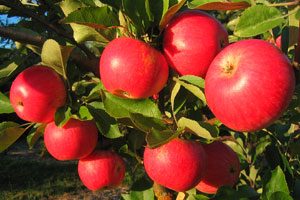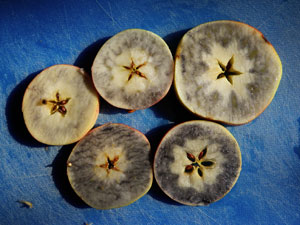With the warm, dry summer we’ve had, fruit is ripening up to three weeks ahead of “normal”. For the last three years, our accumulated heat units are well above the historical average. Since many fruits ripen when they’ve experienced the right amount of heat, it is to be expected that they would ripen earlier in a year like this.
But if you have fruit dropping from the trees, is it always because it’s ripe? Not necessarily. If your trees have not had adequate water this summer to support their fruit load, they will drop some of the fruit early. Regular, deep irrigation through a dry summer is important for fruit quality. Insect damage can also cause fruit to drop- it’s a good idea to pick up and dispose of fallen fruit regularly in case it is harboring insect larvae.
Harvesting Pears
What’s so hard about harvesting? I had a customer ask me the other day why we don’t do U-pick in the orchards. Answer: careless picking can break off fruiting spurs, damaging the potential for fruit next year. When harvesting any tree fruit, it is important to lift and twist carefully to avoid damaging the spurs.
Harvesting European Pears at the right time can be tricky. So many people tell us, “Our pears always rot at the core, it must be a poor variety.” More likely, they are picking their pears too late!
European Pears ripen from the inside out. If the flesh under the skin is ripe, the flesh near the core will be very overripe. Left too long on the tree, they will begin to rot at the core. Picked too green and they don’t develop their full flavor. There is an easy way to tell when they are ripe; when they pick easily! By that, we mean that when you lift a pear, and it breaks cleanly at the stem, it is ripe, and the whole tree should be picked. If you find a fallen pear, that is a good signal to check for ripeness. Even though the pear is hard, if you taste it, it will be sweet.
Unlike European Pears, Asian Pears are ripened on the tree. They will not continue to ripen off the tree! Pick your Asian Pears when the taste and texture are what you like. The most important issue with Asian Pears is that they have thin, tender skins, and any bruising will shorten their storage capability. Handle the ones you want to store very carefully. This is why you see them in the markets in little foam nets.
Harvesting Apples

Akane apples
Frequently asked question: “When are my (Honeycrisp, Gravenstein, Melrose, fill in the blank) apples ripe?”
One way to tell if an apple is ripe, of course, it to taste it. For early ripening varieties that won’t store well, that is a fine way to test for ripeness. Background color can be another good indicator. On many apples, the background color will change from green to cream or light yellow when the fruit is close to ripe.
Experience will help you determine when to pick later ripening varieties for storage. Cutting across the core to see if the seeds are beginning to turn brown is one clue, although some early apples’ seeds don’t turn until they are fully ripe. Another tool that can help you is a starch test. As the fruit ripens, the starch slowly converts to sugar. If all of the starch in the apple has been converted to sugar, the apple is fully ripe, or even overripe, and will not store. You can check to see how much starch is left by testing it with iodine. Iodine reacts with starch, turning it blue-black. This test doesn’t work for all varieties, or every year, as weather can effect how fast the starch changes to sugar. But, along with tasting and background color, it can be a valuable tool.

Apples showing starch reaction to iodine. The top left slice is fully ripe. The bottom right slice is under ripe
To do the test, buy tincture of iodine at the drugstore, and dilute it with water at a ratio of 1 part iodine to 10 parts water. Store this solution in a spray bottle. Take the apple you want to test and cut it across the core. Spray it with the iodine solution. The reaction happens within a few minutes. Apples that are to be stored long term should have at least 1/3 to 1/2 of their starch left.
Storing Apples
The optimal temperature for long term storage of apples is 38°F. This is a refrigerator! If you cannot store apples in a refrigerator, the next best site will have steady temperatures below 40°F. The warmer your storage area, the shorter length of time your apples will store. For every 2° warmer, the fruit ripens 8 times faster. If you have too many apples to store in a refrigerator, put your best fruit, picked at the correct ripeness for storage, in the refrigerator, and use the other fruit first.
Interestingly, Honeycrisp apples benefit from sitting outside for 2-3 days before refrigerating. Most others should go into cold storage immediately.
Modern refrigerators are a dry environment for storing fruit. Your fruit should be stored in perforated plastic bags, and you should have an open pan of water in there to add humidity. Open the door regularly to let ethylene gas escape.
Apples that are to be stored should be the nicest ones; fruit with bruises or broken skins will not store.
Storing Pears
Like apples, you should choose your best fruit for storage. A damaged pear could rot in storage and spoil the whole box. Pears store best at 38°F. Late ripening European pears such as Bosc and Comice will ripen only slowly in cold storage, and should be brought to room temperature a few days or even a week ahead of use.


We cider some of our apples and store some of a number of varieties. Does this mean we should pick some when starch content is as discribed above and pick those for cider later, when higher percent is sugar?
If you’re pressing for cider rather than storing the fruit, let it ripen fully on the tree, or pick when almost ripe then store until you press. The picking late storage varieties when still partially starchy means the ripening in storage takes longer. If you put a ‘storage’ variety like Melrose or Idared in storage when picked fully ripe, it will not store until Feb or March.
Thank you, I appreciate your writing about this. I had no idea when to pick pears.